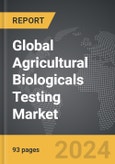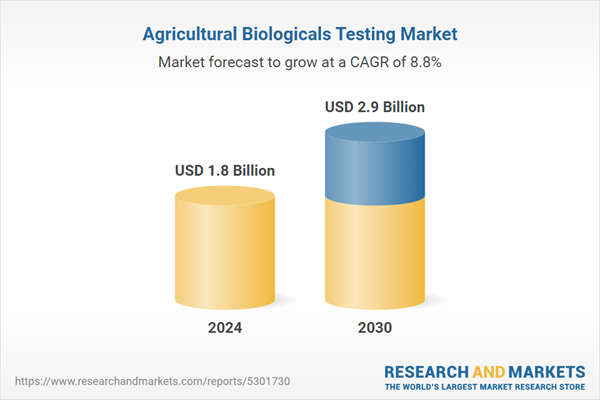The global market for Agricultural Biologicals Testing was valued at US$1.8 Billion in 2024 and is projected to reach US$2.9 Billion by 2030, growing at a CAGR of 8.8% from 2024 to 2030. This comprehensive report provides an in-depth analysis of market trends, drivers, and forecasts, helping you make informed business decisions. The report includes the most recent global tariff developments and how they impact the Agricultural Biologicals Testing market.
Segments: Product Type (Biopesticides, Biofertilizers, Biostimulants); Application (Field Support, Analytical, Regulatory).
Geographic Regions/Countries: World; United States; Canada; Japan; China; Europe (France; Germany; Italy; United Kingdom; Spain; Russia; and Rest of Europe); Asia-Pacific (Australia; India; South Korea; and Rest of Asia-Pacific); Latin America (Argentina; Brazil; Mexico; and Rest of Latin America); Middle East (Iran; Israel; Saudi Arabia; United Arab Emirates; and Rest of Middle East); and Africa.
The analysts continuously track trade developments worldwide, drawing insights from leading global economists and over 200 industry and policy institutions, including think tanks, trade organizations, and national economic advisory bodies. This intelligence is integrated into forecasting models to provide timely, data-driven analysis of emerging risks and opportunities.
Global Agricultural Biologicals Testing Market - Key Trends and Drivers Summarized
Why Is Agricultural Biologicals Testing Essential for Modern Farming?
Agricultural biologicals, which include biopesticides, biofertilizers, and biostimulants, are becoming a cornerstone of sustainable agriculture, as farmers shift away from chemical inputs towards more natural, eco-friendly alternatives. These biological products, derived from natural sources like microorganisms, plant extracts, and organic compounds, are designed to enhance plant growth, improve soil health, and manage pests without the negative environmental impacts commonly associated with synthetic chemicals. However, for biologicals to be effective and safe for widespread use, they must undergo comprehensive testing to assess their efficacy, safety, and compatibility with different agricultural practices. This testing is essential for determining how these products perform under various environmental conditions, ensuring they deliver consistent results in promoting crop resilience, enhancing yields, and minimizing environmental footprints. In addition, biologicals testing is critical to meet the regulatory standards set by agricultural authorities worldwide, ensuring that these products are safe for humans, non-target organisms, and ecosystems. As consumer demand for organic and sustainably sourced produce grows, the role of agricultural biologicals testing in validating the safety and effectiveness of these products becomes even more pivotal, contributing to the adoption of greener farming practices globally.How Do Testing Protocols Ensure the Quality and Reliability of Biologicals?
The testing protocols for agricultural biologicals are highly structured and multidimensional, designed to verify that these products perform as intended while adhering to strict regulatory requirements. These protocols encompass various phases, including laboratory experiments, field trials, and regulatory assessments. Laboratory testing focuses on the biological and chemical composition of the products, analyzing the stability, shelf life, and efficacy of the active ingredients, such as beneficial bacteria, fungi, or plant-derived compounds. This phase ensures that biologicals retain their potency during storage and application, critical for achieving consistent results in the field. Field trials are equally important, simulating real-world agricultural conditions to evaluate how biologicals perform under various stresses, including different climate patterns, pest pressures, and soil types. This stage helps identify any potential limitations or necessary adjustments to optimize the product for different farming environments. Regulatory testing ensures compliance with national and international standards, such as the U.S. EPA, the European Union’s REACH regulations, and other regional authorities, which mandate strict assessments of toxicity, environmental impact, and residual presence on food products. These layers of testing not only safeguard public health and the environment but also build trust among farmers and consumers by ensuring that biologicals are safe and effective alternatives to conventional agrochemicals.What Are the Emerging Trends in Agricultural Biologicals Testing?
Agricultural biologicals testing is evolving rapidly, driven by technological advancements and a growing emphasis on sustainability. One of the most transformative trends in this field is the use of precision agriculture technologies, such as drones, GPS systems, and satellite imagery, to collect more granular data during field trials. These technologies enable researchers to monitor crop health, soil moisture levels, pest populations, and overall ecosystem responses in real-time, providing a more accurate picture of how biological products influence agricultural outcomes. Another significant trend is the incorporation of artificial intelligence (AI) and machine learning (ML) tools in data analysis. These technologies can process large datasets more efficiently than traditional methods, identifying subtle patterns and correlations that can optimize the development and application of biologicals. Bioinformatics, a rapidly growing field, is also playing a critical role in testing by mapping the genetic profiles of microorganisms used in biological products. This genomic mapping allows for the selection of strains with the highest potential efficacy, stability, and adaptability to specific environmental conditions. Another trend that has gained prominence is residue analysis, where products are evaluated for their breakdown rates and potential residues on crops, ensuring that food safety standards are met and aligning with the increasing consumer demand for transparency in food production. These trends not only enhance the reliability and precision of biologicals testing but also help to reduce costs and accelerate the time to market for new products.What Is Driving the Growth of the Agricultural Biologicals Testing Market?
The growth in the agricultural biologicals testing market is driven by several factors, primarily centered around technological advancements, regulatory shifts, and evolving consumer preferences. One of the key drivers is the rising consumer demand for organic and sustainably produced food. As consumers become more aware of the environmental and health impacts of synthetic agrochemicals, there is an increasing preference for products grown with natural inputs, fueling the demand for biological alternatives. This trend, in turn, requires robust testing protocols to ensure these products meet safety and efficacy standards. Additionally, government regulations are becoming more stringent regarding the use of synthetic chemicals in agriculture, with many regions tightening restrictions or outright banning certain harmful pesticides and fertilizers. This regulatory landscape is pushing farmers and agribusinesses toward biologicals as safer, more sustainable alternatives, and comprehensive testing is essential to comply with these legal requirements. The rapid advancement of biotechnology is another major growth driver, as innovations in genetic engineering, microbial research, and bio-based formulations lead to more potent and reliable biological products. Precision agriculture technologies also play a significant role, allowing for more efficient application and monitoring of biologicals, which enhances their appeal to modern farmers looking to maximize yield and minimize waste. Finally, collaborations between agricultural companies, research institutions, and regulatory bodies are fostering innovation and expanding the testing capabilities needed to bring new, high-performance biological products to the market. This combination of consumer trends, technological progress, and regulatory momentum is propelling the agricultural biologicals testing market to grow exponentially in the coming years.Report Scope
The report analyzes the Agricultural Biologicals Testing market, presented in terms of units. The analysis covers the key segments and geographic regions outlined below.Segments: Product Type (Biopesticides, Biofertilizers, Biostimulants); Application (Field Support, Analytical, Regulatory).
Geographic Regions/Countries: World; United States; Canada; Japan; China; Europe (France; Germany; Italy; United Kingdom; Spain; Russia; and Rest of Europe); Asia-Pacific (Australia; India; South Korea; and Rest of Asia-Pacific); Latin America (Argentina; Brazil; Mexico; and Rest of Latin America); Middle East (Iran; Israel; Saudi Arabia; United Arab Emirates; and Rest of Middle East); and Africa.
Key Insights:
- Market Growth: Understand the significant growth trajectory of the Biopesticides segment, which is expected to reach US$1.5 Billion by 2030 with a CAGR of a 9.2%. The Biofertilizers segment is also set to grow at 8.5% CAGR over the analysis period.
- Regional Analysis: Gain insights into the U.S. market, valued at $455.9 Million in 2024, and China, forecasted to grow at an impressive 12.0% CAGR to reach $666.2 Million by 2030. Discover growth trends in other key regions, including Japan, Canada, Germany, and the Asia-Pacific.
Why You Should Buy This Report:
- Detailed Market Analysis: Access a thorough analysis of the Global Agricultural Biologicals Testing Market, covering all major geographic regions and market segments.
- Competitive Insights: Get an overview of the competitive landscape, including the market presence of major players across different geographies.
- Future Trends and Drivers: Understand the key trends and drivers shaping the future of the Global Agricultural Biologicals Testing Market.
- Actionable Insights: Benefit from actionable insights that can help you identify new revenue opportunities and make strategic business decisions.
Key Questions Answered:
- How is the Global Agricultural Biologicals Testing Market expected to evolve by 2030?
- What are the main drivers and restraints affecting the market?
- Which market segments will grow the most over the forecast period?
- How will market shares for different regions and segments change by 2030?
- Who are the leading players in the market, and what are their prospects?
Report Features:
- Comprehensive Market Data: Independent analysis of annual sales and market forecasts in US$ Million from 2024 to 2030.
- In-Depth Regional Analysis: Detailed insights into key markets, including the U.S., China, Japan, Canada, Europe, Asia-Pacific, Latin America, Middle East, and Africa.
- Company Profiles: Coverage of players such as Apal Agricultural Laboratory, Bionema Limited, Biotecnologie BT, Eurofins Scientific SE, I2L Research and more.
- Complimentary Updates: Receive free report updates for one year to keep you informed of the latest market developments.
Some of the 37 companies featured in this Agricultural Biologicals Testing market report include:
- Apal Agricultural Laboratory
- Bionema Limited
- Biotecnologie BT
- Eurofins Scientific SE
- I2L Research
- Laus GmbH
- RJ Hill Laboratories Ltd
- SGS S.A.
- Staphyt SA
- Anadiag Group
- Staphyt SA
- SynTech Research
Tariff Impact Analysis: Key Insights for 2025
Global tariff negotiations across 180+ countries are reshaping supply chains, costs, and competitiveness. This report reflects the latest developments as of April 2025 and incorporates forward-looking insights into the market outlook.The analysts continuously track trade developments worldwide, drawing insights from leading global economists and over 200 industry and policy institutions, including think tanks, trade organizations, and national economic advisory bodies. This intelligence is integrated into forecasting models to provide timely, data-driven analysis of emerging risks and opportunities.
What’s Included in This Edition:
- Tariff-adjusted market forecasts by region and segment
- Analysis of cost and supply chain implications by sourcing and trade exposure
- Strategic insights into geographic shifts
Buyers receive a free July 2025 update with:
- Finalized tariff impacts and new trade agreement effects
- Updated projections reflecting global sourcing and cost shifts
- Expanded country-specific coverage across the industry
Table of Contents
I. METHODOLOGYII. EXECUTIVE SUMMARY2. FOCUS ON SELECT PLAYERSIII. MARKET ANALYSISSOUTH KOREAREST OF ASIA-PACIFICARGENTINABRAZILMEXICOREST OF LATIN AMERICAIRANISRAELSAUDI ARABIAUNITED ARAB EMIRATESREST OF MIDDLE EASTIV. COMPETITION
1. MARKET OVERVIEW
3. MARKET TRENDS & DRIVERS
4. GLOBAL MARKET PERSPECTIVE
UNITED STATES
CANADA
JAPAN
CHINA
EUROPE
FRANCE
GERMANY
ITALY
UNITED KINGDOM
SPAIN
RUSSIA
REST OF EUROPE
ASIA-PACIFIC
AUSTRALIA
INDIA
LATIN AMERICA
MIDDLE EAST
AFRICA
Companies Mentioned (Partial List)
A selection of companies mentioned in this report includes, but is not limited to:
- Apal Agricultural Laboratory
- Bionema Limited
- Biotecnologie BT
- Eurofins Scientific SE
- I2L Research
- Laus GmbH
- RJ Hill Laboratories Ltd
- SGS S.A.
- Staphyt SA
- Anadiag Group
- Staphyt SA
- SynTech Research
Table Information
| Report Attribute | Details |
|---|---|
| No. of Pages | 93 |
| Published | April 2025 |
| Forecast Period | 2024 - 2030 |
| Estimated Market Value ( USD | $ 1.8 Billion |
| Forecasted Market Value ( USD | $ 2.9 Billion |
| Compound Annual Growth Rate | 8.8% |
| Regions Covered | Global |









